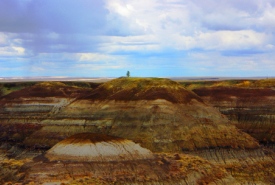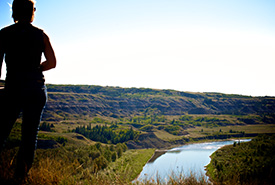Red Deer River Conservation Region

Horseshoe Canyon, Alberta (Photo by NCC)
The Red Deer Conservation Region contains the Red Deer River Priority Area and covers more than 615,000 hectares (1.5 million acres). The Nature Conservancy of Canada (NCC) has been actively working to conserve habitat within this area for more than a decade. During this time, NCC has conserved more than 3,100 hectares (7,640 acres) here.
The area was selected for focused conservation because it contains the highest density of intact parkland in central Alberta. It also features the Rumsey Ecological Reserve and Rumsey Natural Area. Together, these two areas comprise the largest remaining block of non-sandy aspen parkland habitat in the world.
NCC has undertaken these important conservation efforts with the significant help of landowners, partners like Alberta Fish and Game Association, Alberta Conservation Association and Ducks Unlimited Canada, and sponsors like TransCanada.
Large blocks of intact native grasslands, extensive wetlands and highly productive waterfowl, migratory bird and wildlife habitat are found here.
More than 75 per cent of Alberta's original mixed grassland has been converted to tame forage and annual cropping. Up to 80 per cent of the region's wetlands have been converted or degraded. Only 17 per cent of the original Alberta foothills fescue grassland remains, and the largest remaining tracts of foothills fescue grasslands in the world are found here.
Grasslands are fragile but ecologically important. They support a large number of at-risk species that rely on this habitat for at least some stage of their life cycle. Bird species, such as the endangered piping plover, burrowing owl, ferruginous hawk and peregrine falcon, are iconic grasslands creatures that are under increasing threat from habitat loss. Burrowing owls, with their underground nests, are especially vulnerable to pervasive human development.
The area contains the highest density of remaining native parkland in the central Alberta region, which supports populations of native plants and animals. This region’s diversity of habitats favours abundant wildlife, such as mule deer, coyote, moose and red-tailed hawk.
Featured project
- Located 17 kilometres west of Drumheller on Highway 9, the Nodwell property is in an isolated pocket of badlands in the Alberta prairie. This vista is familiar to many Albertans and a favourite spot for tourists to catch their first glimpse of this unique aspect of Alberta’s natural heritage.
- The Meyers property is a 68-hectare (169-acre) easement located along the Battle River, a tributary of the North Saskatchewan River.
Come visit us
Visitors are welcome at many conservation areas protected by NCC. These special, natural places provide excellent opportunities for hiking, birdwatching, nature photography and other compatible recreation activities.
This year, get out into nature. Go to connect2nature.ca for information on visiting our properties in Alberta. We'd love to show you what we are able to accomplish, thanks to the generous support of our landowner partners and donors.

Fyten Lea property overlooking the Red Deer River, AB (Photo by NCC)
Permitted activities on NCC properties and access
Permitted activities on NCC properties are defined by each property's management plan. There is no one-size-fits-all approach to the kinds of recreation that visitors can engage in on our conservation lands. Some properties remain completely closed to the public in order to protect the sensitive ecology that makes the land so important to conserve. Other conservation areas can withstand a wide range of recreational pursuits without any harm to the natural habitat.
Our partners in this region
-

Repsol is an integrated oil and gas company, with its Canadian headquarters based in Calgary, Alberta. Repsol has signed a five-year agreement to support NCC’s work in the Red Deer River Natural Area from 2014 to 2019, to help support securement and stewardship actions in the area.
Find an NCC representative in this area:
Red Deer River: Delaney Schlemko





